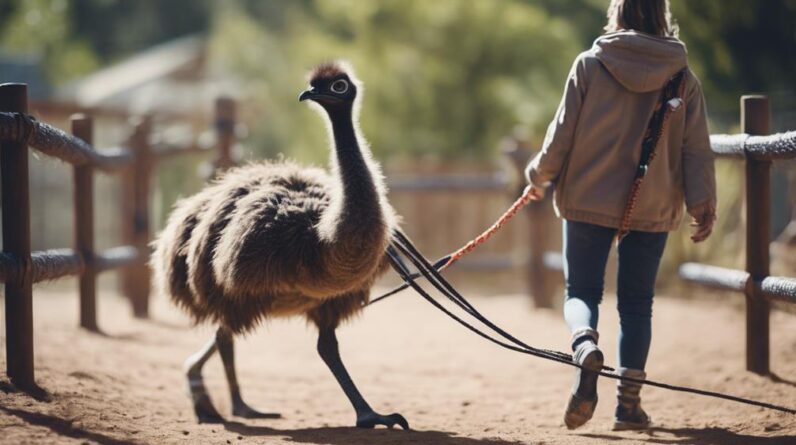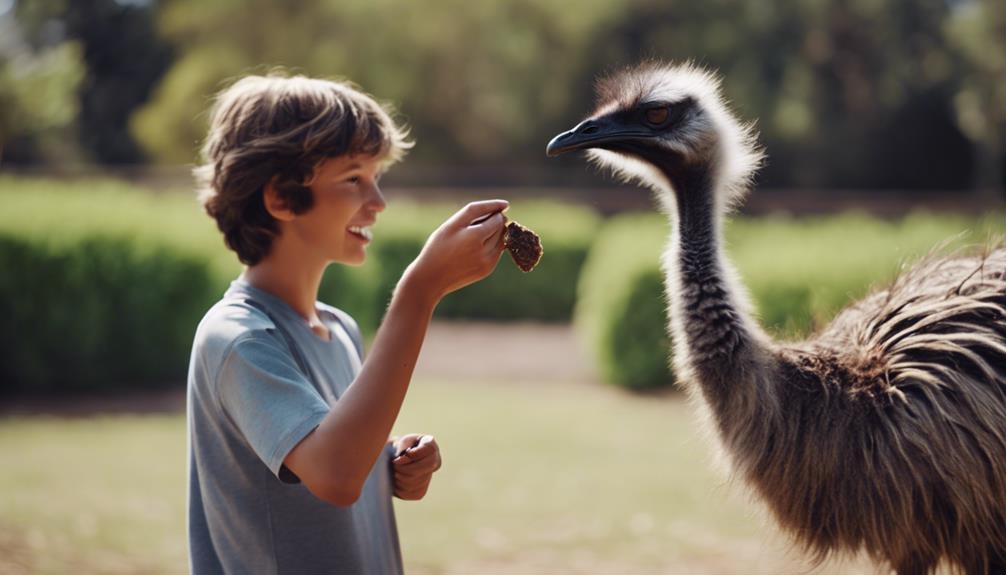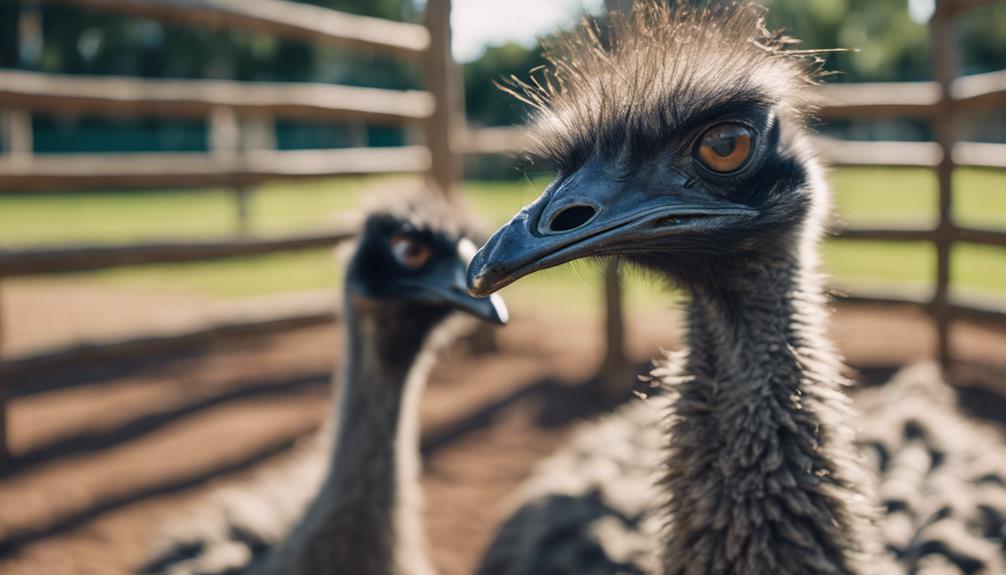
When working with young emus, creating a supportive environment is crucial for their development. However, there's a specific aspect of their training that often gets overlooked but holds significant importance. It's a subtle yet powerful way to enhance your bond with these unique creatures and ensure successful training outcomes. So, are you ready to uncover this essential tip that can make a world of difference in your emu training journey?
Key Takeaways
- Establish trust through calm and patient interactions.
- Use positive reinforcement for desired behaviors.
- Create a consistent training schedule for routine.
- Provide ample space and enrichment in the environment.
- Monitor progress, adjust techniques, and celebrate milestones.
Understanding Emu Behavior

To train young emus effectively, it's essential to understand their behavior patterns and instincts. Emus are powerful and assertive creatures by nature, exhibiting a hierarchical social structure where dominance plays a crucial role. As a trainer seeking to establish authority, you must assert yourself confidently and consistently. Emus respond well to clear boundaries and firm leadership, so displaying assertiveness in your interactions is key.
Emus are highly curious animals, often investigating their surroundings with a keen interest. Leveraging this curiosity can be advantageous during training sessions. Introduce new stimuli gradually, allowing the emus to familiarize themselves at their own pace. By incorporating novel objects or obstacles into their environment, you can stimulate their cognitive abilities and keep them engaged.
Furthermore, emus are known for their strong maternal instincts, which manifest in their protective behavior towards their young. Understanding this trait can help you establish a sense of security and trust with the young emus under your care. By acknowledging and respecting their innate instincts, you can build a more profound connection and facilitate a smoother training process.
Setting Up a Training Environment
Understanding the behavioral tendencies and natural inclinations of young emus can significantly impact how you design and arrange their training environment. To set up an effective training environment for young emus, consider the following:
- Space: Provide ample space for the emus to move around freely. Emus are active birds that require room to exercise and explore. A spacious environment will prevent them from feeling confined and allow them to exhibit natural behaviors.
- Enrichment: Incorporate various forms of enrichment such as toys, puzzles, and natural elements like branches or rocks. Emus are curious animals that thrive on mental stimulation. Enrichment activities will keep them engaged and prevent boredom during training sessions.
- Safety Measures: Ensure the training environment is secure and free from potential hazards. Emus can be easily startled and may exhibit unpredictable behaviors if they feel threatened. Implement safety measures to protect both the emus and the trainers during training sessions.
Establishing Trust and Bonding

Establishing a strong foundation of trust and bonding with young emus is essential for fostering a positive and cooperative relationship during training sessions. Building trust begins with approaching the emus calmly and confidently. Emus are perceptive animals; they can sense fear and hesitation. Show them you're in control by maintaining a steady demeanor and using assertive but gentle gestures. Spend time with them regularly, engaging in activities that they enjoy, such as providing treats or grooming. This helps them associate you with positive experiences, strengthening the bond between you.
Consistency is key in building trust. Emus thrive on routine and can become unsettled by sudden changes. Ensure your interactions with them follow a predictable pattern, so they can anticipate what to expect from you. Be patient and understanding; trust takes time to develop. Avoid forcing interactions or moving too quickly, as this can erode the trust you've worked hard to build. By investing time and effort in establishing trust and bonding with young emus, you lay a solid foundation for successful training sessions ahead.
Consistent Training Schedule
Maintaining a consistent training schedule is crucial for the successful development and progress of young emus in their training journey. Consistency provides structure and predictability, which are essential for the young emus to learn and grow effectively. Here are three key reasons why a consistent training schedule is paramount:
- Establishes Routine: A consistent schedule helps young emus understand what to expect, creating a sense of order and security. This routine fosters a stable learning environment where emus can focus on training tasks without distractions.
- Builds Trust: By adhering to a set schedule, you demonstrate reliability and commitment to the emus. This consistency builds trust and strengthens the bond between trainer and emu, essential for successful training outcomes.
- Optimizes Learning: Regular training sessions at consistent times allow young emus to adapt and improve their skills progressively. This optimization of learning potential enhances the effectiveness of the training program, leading to better results in a shorter time frame.
Positive Reinforcement Techniques

Implementing positive reinforcement techniques is key to fostering a strong connection and motivation in young emus during their training process. Emus respond well to positive reinforcement, which involves rewarding desired behaviors to encourage their repetition. When training young emus, it's crucial to use rewards such as treats or verbal praise immediately after they exhibit the desired behavior. This reinforces the association between the action and the reward, making it more likely for the behavior to be repeated in the future.
Consistency is paramount when employing positive reinforcement techniques. Emus, like many animals, thrive on routine and clear expectations. By consistently rewarding positive behaviors and ignoring unwanted ones, you establish a clear communication channel with the emus. This clarity helps them understand what's expected of them, leading to quicker learning and better results in their training.
Furthermore, positive reinforcement creates a positive training environment, where the emus feel encouraged to engage and participate. This positivity enhances their motivation and willingness to learn, making the training process more effective and enjoyable for both the emus and the trainer.
Teaching Basic Commands
To effectively teach basic commands to young emus, begin by introducing clear and consistent verbal cues paired with immediate positive reinforcement. Emus are intelligent creatures that respond well to structured training. Here's how you can effectively teach them basic commands:
- Establish Clear Verbal Cues: Emus are attentive to sound, so choose distinct commands like 'halt,' 'move,' or 'stay.' Consistency in your choice of words is crucial for the emus to associate the command with the desired action.
- Use Positive Reinforcement: Emus are motivated by rewards. When they follow a command correctly, immediately reward them with treats or verbal praise. This positive reinforcement creates a strong connection between the command and the desired behavior.
- Practice Regularly: Consistent practice is key to solidifying their understanding of the commands. Emus thrive on routine, so incorporate short training sessions into their daily schedule to reinforce what they've learned.
Socializing With Other Emus

When introducing young emus to socializing with other emus, focus on creating opportunities for natural interactions that allow them to learn and develop social skills through observation and engagement. Emus are naturally social birds, and these interactions are crucial for their social development. Encourage group activities where they can learn from one another and establish their pecking order. Emus often communicate through vocalizations, body language, and even gentle pecks, so observe these interactions closely to ensure they're learning proper social behaviors.
It is essential to provide a safe environment for these social interactions, as young emus can be sensitive to aggressive behavior from their peers. Monitor their interactions initially to prevent any bullying or aggressive behaviors. As they become more comfortable with each other, they'll establish their social hierarchy naturally.
Handling and Grooming Practices
Incorporate regular handling and grooming practices into your routine to ensure the well-being and health of young emus. Proper handling and grooming not only maintain their physical health but also contribute to their overall well-being and behavior.
Here are three essential practices to follow:
- Regular Handling: Emus are naturally curious birds, but they can also be skittish. By regularly handling them from a young age, you help them become accustomed to human interaction, making training easier as they grow. Start by gently stroking their feathers and gradually introduce more handling to build trust and familiarity.
- Nail Trimming: Emus have sharp nails that can grow long and cause discomfort or even injury. Trim their nails regularly using specialized tools to prevent them from becoming too long. This practice not only keeps the emus comfortable but also reduces the risk of scratches during handling.
- Feather Maintenance: Emus have unique feathers that require regular maintenance. Check for any debris or parasites in their feathers and gently clean them to ensure cleanliness and prevent any skin irritations. Additionally, inspect their skin for any signs of dryness or irritation, addressing any issues promptly to maintain their overall health and appearance.
Overcoming Training Challenges

Regular handling and grooming practices not only contribute to the well-being of young emus but also play a vital role in overcoming training challenges that may arise. When faced with difficulties during training, it's crucial to approach the situation with a strategic mindset. Emus are intelligent creatures that respond well to consistent and firm training methods. One common challenge is stubbornness, which can be tackled by establishing yourself as the dominant figure through assertive commands and positive reinforcement. Additionally, emus can sometimes display fear or aggression, requiring a patient approach to gradually build trust and reduce anxiety.
| Training Challenge | Strategy | Outcome |
|---|---|---|
| Stubborn Behavior | Assertive commands and reinforcement | Increased obedience |
| Fearful Reactions | Patient approach to build trust | Reduced anxiety levels |
| Aggressive Tendencies | Consistent training for behavior modification | Improved temperament |
Health and Wellness Check-ups
Ensuring the overall well-being of young emus involves prioritizing regular health and wellness check-ups. These check-ups are crucial for maintaining the health and vitality of your emus.
Here are three key points to consider when scheduling and conducting health and wellness check-ups for your young emus:
- Regular Veterinary Visits: Arrange for routine visits to a qualified avian veterinarian who specializes in emus. These professionals can conduct thorough examinations, administer necessary vaccinations, and provide expert guidance on diet and care.
- Nutritional Assessments: Ensure your young emus are receiving a balanced and nutritious diet. A proper nutritional assessment can identify any deficiencies or excesses in their diet, allowing you to make adjustments accordingly.
- Behavioral Observations: Monitor the behavior of your emus closely during check-ups. Changes in behavior can sometimes indicate underlying health issues. By observing their behavior regularly, you can catch any potential problems early and address them promptly.
Monitoring Progress and Adjusting

To effectively monitor the progress and make necessary adjustments in the care of young emus, keen observation and data tracking play a vital role. Monitoring progress involves closely observing the emus during training sessions, noting their responses to commands, and assessing their overall behavior. By keeping detailed records of their performance, you can identify patterns, strengths, and areas that need improvement. Utilizing this data allows you to tailor training techniques to suit each emu's unique needs, ensuring optimal progress.
Adjustments should be made promptly based on the observed progress. If an emu is struggling with a particular command, consider modifying the training approach or breaking down the task into smaller steps. Additionally, changes in diet, exercise routine, or environment may be necessary to support their development. By continuously monitoring and adapting your training methods, you demonstrate flexibility and commitment to the emus' growth. This proactive approach is key to achieving successful training outcomes and nurturing the potential of these remarkable creatures.
Celebrating Training Milestones
Upon reaching significant milestones in the training of young emus, recognizing and celebrating their achievements can foster a positive training environment and reinforce desired behaviors. Acknowledging their progress not only boosts the emus' confidence but also strengthens the bond between trainer and bird.
Here are three powerful ways to celebrate training milestones effectively:
- Public Recognition: Highlight the accomplishment in front of other emus to showcase the successful behavior. Emus, like many social animals, respond well to peer acknowledgment and are likely to repeat the action to receive further praise.
- Treat Rewards: Offering a special treat as a reward for reaching a milestone can create a positive association with the achieved behavior. Emus are known to be food-motivated, making treats an effective tool for reinforcing training progress.
- Physical Affection: Emus, despite their seemingly aloof demeanor, can appreciate physical touch as a form of celebration. A gentle pat on the neck or a soothing voice can communicate approval and deepen the trust between you and the emu.
Celebrating training milestones with these strategies won't only solidify the progress made but also encourage continued learning and cooperation.
Frequently Asked Questions
Can Emus Be Trained to Perform Tricks or Stunts?
Yes, emus can be trained to perform tricks or stunts. With patience, consistency, and positive reinforcement, you can teach them various behaviors. Emus are intelligent creatures and can learn to do impressive feats with the right training.
How Do You Prevent Emus From Becoming Aggressive During Training?
To prevent emus from becoming aggressive during training, establish clear boundaries and be consistent in enforcing them. Use positive reinforcement techniques to reward good behavior. Remember, emus respond well to calm and assertive leadership.
Are There Specific Training Techniques for Shy or Timid Emus?
To train shy or timid emus effectively, establish trust through patient, consistent interactions. Use positive reinforcement like treats and verbal praise. Gradually introduce new experiences to build confidence. Stay calm and assertive to instill a sense of security.
What Should Be Done if an Emu Refuses to Cooperate During Training?
When an emu refuses to cooperate during training, assert your dominance firmly and consistently. Implement positive reinforcement techniques to encourage desired behaviors. Be patient and persistent, as establishing trust and respect takes time and effort.
Is It Possible to Train Older Emus or Is It Best to Start When They Are Young?
Like a well-tuned engine, older emus possess wisdom and experience that can enhance training. Starting young is ideal for imprinting behaviors, but with patience and skill, older emus can also learn effectively.
Conclusion
In conclusion, training young emus requires dedication, patience, and a deep understanding of their behavior. By creating a nurturing environment, establishing trust, and using positive reinforcement, you can build a strong bond with these intelligent birds.
Consistency, perseverance, and celebrating milestones are key to their development. But, have you considered how your training methods can adapt as they grow and change? Reflect on this to ensure continued success in your emu training journey.





